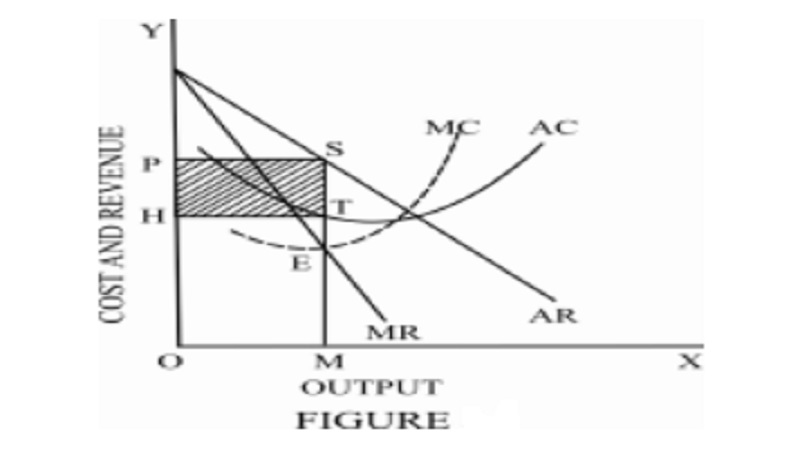Chapter: 11th 12th std standard Indian Economy Economic status Higher secondary school College
Monopoly : Price and Output Determination : Advantages, Disadvantages

Price and Output Determination
A monopolist like a perfectly competitive firm tries to maximise his profits.
A monopoly firm faces a downward sloping demand curve, that is, its average revenue curve. The downward sloping demand curve implies that larger output can be sold only by reducing the price. Its marginal revenue curve will be below the average revenue curve.
The average cost curve is 'U' shaped. The monopolist will be in equilibrium when MC = MR and the MC curve cuts the MR curve from below.
In figure, AR is the Average Revenue Curve and MR is the Marginal revenue curve. AR curve is falling and MR curve lies below AR. The monopolist is in equilibrium at E where MR = MC. He produces OM units of output and fixes price at OP. At OM output, the average revenue is MS and average cost MT. Therefore the profit per unit is MS-MT = TS. Total profit is average profit (TS) multiplied by output (OM), which is equal to HTSP. The monopolist is in equilibrium at point E and produces OM output at which he is earning maximum profit. The monopoly price is higher than the marginal revenue and marginal cost.
Advantages
1. Monopoly firms have large-scale production possibilities and also can enjoy both internal and external economies. This will result in the reduction of costs of production. Output can be sold at low prices. This is beneficial to the consumers.
2. Monopoly firms have vast financial resources which could be used for research and development. This will enable the firms to innovate quickly.
3. There are a number of weak firms in an industry. These firms can combine together in the form of monopoly to meet competition. In such a case, market can be expanded.
Although there are some advantages, there is a danger that monopoly power might be misused for exploiting the consumers.
Disadvantages
1. A monopolist always charges a high price, which is higher than the competitive price. Thus a monopolist exploits the consumers.
2. A monopolist is interested in getting maximum profit. He may restrict the output and raise prices. Thus, he creates artificial scarcity for his product.
3. A monopolist often charges different prices for the same product from different consumers. He extracts maximum price according to the ability to pay of different consumers.
4. A monopolist uses large-scale production and huge resources to promote his own selfish interest. He may adopt wrong practices to establish absolute monopoly power.
5. In a country dominated by monopolies, wealth is concentrated in the hands of a few. It will lead to inequality of incomes. This is against the principle of the socialistic pattern of society.
Related Topics